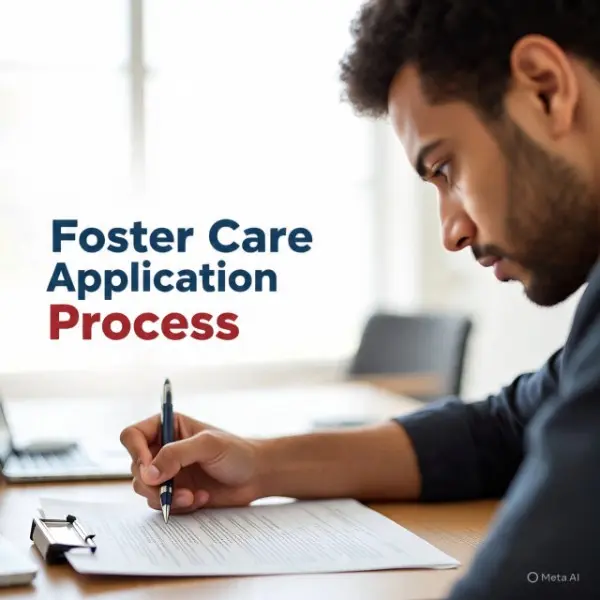How to Fund Adoption: 7 Smart Ways That Work

If I show you how to fund adoption without emptying your bank account would you buy me a drink?
Adoption is a wonderful experience, but for so many prospective parents, the expense is daunting. Let’s consider a couple—David and Laura—who had hoped for years for a child in their household. When their research started, they learned that adoption costs might reach tens of thousands.
They worried money would be a barrier between their dream and reality. Rather than emptying their bank accounts, they looked for innovative solutions and found how to fund adoption without touching their money.
Their experience advocates for a different model of paying for adoption: it about how to fund adoption and not about emptying your purse—it’s about coming up with effective, smart, strategic solutions.
The truth is that thousands of families face this same economic barrier each year, and that’s because they haven’t understood how to fund adoption without touching their money.
As recent reports indicate, an estimated 135,000 children are adopted annually within the United States, but many families would adopt if there were no economic deterrents.
Fortunately, with proper planning in place and knowledge of how to fund adoption effectively, financial deterrents can be overcome.
Here in this in-depth report, we’ll uncover how to fund adoption without breaking the bank, pinpoint blind spots to avoid, and tackle pressing issues keeping you awake at night.
Once you reach understand this, you’ll see how money is not an obstacle in growing your family—it simply requires an integrated plan along with an openness towards diversification in sources of finance.
What is the Cost of Adoption?
It is important, before discussing how to fund adoption, to recognize why costs are so extremely different and what drives those costs. Domestic adoption is usually between $20,000 and $45,000; international adoption can exceed even those costs in some cases up to or even over $60,000.
These are not gratuitous costs—they encompass basic services such as agency overhead, court proceedings, medical for the birth mother, counseling, travel, and after-placement counseling.
Foster-adopt programs are most frequently and least expensive, costing mostly less than $3,000.
It does, though, come with a different set of issues and schedules families should take into account. Financial expenses vary significantly based on a couple of variables: what type of adoption you pursue, where you are geographically located, which agency or attorney you employ, and unforeseeable circumstances that may occur while in the adoption process.
Most international adoption procedures involve several additional costs such as translation fees, legalized documents, multiple trips overseas to a child’s native land, and extended stays abroad.
Understanding this economic situation is step one in developing a realistic adoption funding plan.
The best thing about understanding how to fund adoption doesn’t entail emptying the bank account on adoption funding. With careful planning, outside help, and innovative strategies, adoption is achievable for families at any level.
1. Look Out For Adoption Grants That Are Non-Repaying
Grants represent one of the most effective and stress-free ways to cover adoption expenses. Unlike loans, grants don’t require repayment, making them an excellent foundation for your funding strategy. Numerous organizations exist specifically to support adoptive families, each with its own mission and eligibility criteria.
Some leading grant givers are HelpUsAdopt.org, which offers grants up to $15,000; Gift of Adoption Fund, which offers support between $1,000 and $7,500; and National Adoption Foundation, which offers grants as well as low-interest adoptive loans. Church groups like Lifesong for Orphans and Show Hope also offer large sums of financial support for adoptive families.
The grant application usually requires you to provide detailed financial information, personal essays describing your adoption experience, references, and in some cases, interviews. These grants are competitive but are granted on a needs basis, dedication, and quality of application rather than solely on a financial basis.
Understanding how to fund adoption with grants requires patience, persistence, and thoughtful timing. I will advise that you file applications on time in your adoption journey since reviews can last several months.
File applications with several organizations to cover a wide range since families receiving grants usually obtain multiple sources to fund it. Maintain detailed records for all applications filed and take appropriate follow-ups to show dedication and professionalism.
2. Benefit From the Federal Adoption Tax Credit
The U.S. adoption tax credit is a large financial incentive made available to adoptive families. In 2025, it is a non-refundable credit for qualified adoption expenses up to $16,810 per child—an amount large enough in itself that it can significantly reduce your out-of-pocket cost.
Necessary adoption expenses are qualified adoption fees, court costs, attorney fees, travel costs, and other expenses that are directly used for securing a legal adoption for a qualified child. Both international adoption and domestic adoption are qualified for this credit; nonetheless, when you can take it differs between the two.
For a domestic adoption, you can take the credit in the year you paid qualified expenses even if the adoption does not become final.
On an international adoption, you can take it only if the adoption is made final. Families adopting children with special needs can take the full amount of credit even if their actual qualified costs were lower.
The credit does come with income limits—it does begin phasing out for families whose modified adjusted gross income is over some set levels and is fully phased out at some income levels.
When researching how to fund adoption with a tax benefit, talk with a qualified tax professional or financial advisor so you understand what you are qualified for and make a full benefit of this valuable incentive. Precise records of everything you spend are essential in making this credit a success.
3. How To Fund Adoption Through Employer Adoption Programs:
The business community itself has changed dramatically in recent decades so that today an increased number of employers recognize adoption as a significant family-building option deserving support. As a result, hundreds of major companies now make adoption benefits a component within their complete benefits package.
These programs vary significantly but typically include financial remuneration between $1,000 and $20,000 per adoption, paid adoption leave (often separate from other parental leave), adoption support resources and counseling access, and, in some instances, adoption transition support in later stages.
Some companies are members of adoption agencies in an attempt at lower service costs or pre-existing employee support programs for adoptive families.
Large technology companies, banks, health care organizations, and government agencies are prominent adoptive benefit providers. But even smaller businesses are beginning to adopt such benefits as a competitive edge for securing talent and a show of support for families.
If you are not in a plan with adoption benefits, don’t lose hope. Go to your HR department with a carefully researched proposal about how adoption benefits would benefit you and the company.
Many companies are in a mood to adopt a new benefit when shown strong facts about their value and comparative affordability relative to other employee benefits.
Taking advantage of employer benefits is an intelligent model for paying for adoption by utilizing workplace benefits instead of drawing on personal resources. Even if the benefit doesn’t pay for adoption in full, it can form a substantial base for paying for adoption in its entirety.
4. How To Fund Adoption Through Crowdfunding From Reliable Online Platforms:
The internet age has revolutionized fundraising by linking adoptive families with givers around the globe via crowdfunding sites.
Sites like GoFundMe, AdoptTogether, Fundly, and Pure Charity enable you to share your adoption story and raise funds in front of your friends, your relatives, colleagues, as well as even caring strangers.
Effective crowdfunding campaigns also have a few common denominators: effective storytelling, frequent updates, open communication about where funds are spent, and sincere appreciation for every contribution.
Your campaign should incorporate photos, videos, and blog posts that make donors feel a part of your experience and invested in you.
AdoptTogether, which is specifically for adoption fundraising, is unlike any other fundraising site in that it allows supporters to buy an actual item for your adoption fund (such as a home study or legal fees) instead of a monetary donation.
Most people are more apt to make a sizeable contribution in hopes of seeing specifically what their contribution is towards because you are so transparent.
Building momentum requires constant innovation and effort. Post about your campaign on all social media platforms, send personalized messages to donors, and make frequent posts even when there is no swift gain.
Most successful campaigns take a few months for fundraising, when donations come in waves, when families share about milestones and progress.
Transparency is key in ensuring donor confidence for repeat support. Report failures as much as successes, clarify unforeseen costs when made, and at all times show appreciation for gifts from those in support of you.
Such openness is bound to foster even more support in addition to word-of-mouth recommendations towards other would-be donors.
5. Organize Community-Based Fundraising Events:
Local fundraising events allow you to create support in your immediate area while fundraising in a personal, one-on-one manner. These events allow you to share about your story in person, share about adoption with individuals, and make lifelong connections with donors who become invested in your story.
Some main fundraising events include charity dinners with silent auctions, fun runs or walks, bake sales in local venues, garage sales with items donated for sale, benefit concerts, golf tournaments, and theme parties for a set entry charge. Here is the catch: selecting events that are consistent with talents, interests, and community values.
Event success is a product of careful planning, cooperative communities, and volunteers. Start by finding venues that may donate use of their facility, businesses that may donate prizes or sponsorships, and volunteers that may donate hours towards organization and promotion.
Local newspapers frequently publish adoption stories in hopes of free publicity for events.
Artistic elements can even improve fundraising success. Consider creating and selling adoption-themed items such as t-shirts, mugs, or car magnets. You can offer naming rights for an adoption-related expense in exchange for major gifts. Create photo display presentations illustrating your adoption experience and dreams.
For any families involved, funding adoption gets less stressful and more significant when balanced with a supportive community that gets it and honors their path towards motherhood or fatherhood.
6. Investigate Adoption Loans with Low Interest Programs:
Whereas grants and fundraising should comprise a base for your funding plan, adoption loans can accommodate additional bridge finance where other sources prove inadequate or where circumstances call for prompt adoption expense payout.
Some banking organizations and finance companies are dedicated to adoption financing at beneficial terms rather than standard individual loans.
Such organizations as GoodStart Financial and Adoptions Together Financial are some examples of organizations offering adoption-oriented financing at lower interest rates, easy repayments, as well as simplified applications directly prepared for families in adoption schedules.
These adoption-specific lenders are familiar with adoption costs and cycles and may provide such features as delayed payment until tax credits are available or graduated repayment schedules beginning at a lower amount increasing over a period. Some agencies even provide in-house financing or co-pays with favored lenders.
Pre-approve any loan by thoroughly reading all terms, like interest rates, charges, repayment schedules, and early repayment penalties. Consider how it would fit in your future budget plan because now you would also have child-rearing expenses.
Strategic use of loans makes it an effective bridging finance product instead of a means for a longer-term financial need. Most families borrow for short-term needs while still actively seeking grants and fundraising in a bid to repay the debt as soon as possible.
Common Errors Families Commit When Financing Adoption:

Well-meaning families may blunder into financial pitfalls that render their adoption process fraught with peril. It is very possible to avoid trouble by learning what befell other individuals:
Depending solely on a single source of finance, relying completely on loans, crowdfunding, or any other source leaves you exposed if it is not satisfactory. Efficient families diversify their sources of finance.
Insufficient research about eligibility criteria – There are certain specified rules about income restrictions, family size, adoption type, or date in most grants, tax credits, and financial assistance programs. Failing to observe such information may result in forgone opportunities or delayed financial support.
Poor timing and planning – Waiting until adoption costs are due creates unnecessary pressure and restricts access to money. Forethought enables grant applications, fundraising drives, and regular saving.
Financial overextension – Borrowing too much or exhausting emergency funds can cause long-term problems affecting security for your loved ones. Temper ambition with prudent financial handling.
Poor records – Many adoption fund sources involve a great amount of accounting for grants, tax credits, and reimbursements. Poor records may cause lost reimbursement or benefits.
Overshooting in adoption costs – Most individuals end up spending more in adoption costs when they overbid or pay an unaffordable adoption cost.
Conclusion On How To Fund Adoption:
John Case, The adoption cost may, on a cursory glance, seem prohibitive, but there is no reason it should hold you back when you are resourceful, resilient, and plan ahead. These 7 detailed approaches demonstrate that adoptive funding success is not about having bottomless pockets or jumping headlong into debt.
There are grants and tax credits, support from employers, crowdfunding, and community support all pointing you in one direction only: home for your child. David and Laura’s is one such story—that thousands are—that shows how resourcefulness, tenacity, and community mobilization overcome financial hurdles.
Eventually, they brought their child home not by virtue of having boundless wealth, but because they funded strategically, tapped available resources, and were steadfast in their intent despite setbacks.
Your adoption process is worthy of the same dedication and planning. Get a head start today by learning about available grants, exploring what your employer offers, making rough budgets, and constructing support groups.
Every step in the right direction gets you one step closer to your dream with momentum leading into tomorrow. Keep in mind, it’s a one-time upfront adoption cost paid for an investment in your family’s tomorrow and a child’s tomorrow.
With careful planning and fully implementing all you learned from this guide on how to fund adoption without touching your bank account, financial stress should never again stop loving families from achieving their dreams, or deprive children of a home.
Frequently Asked Questions About Adoption Costs:
What is a realistic amount for adoption costs?
They range considerably depending on adoption level, geography, and individual situations.
Domestic agency adoption ranges between $20,000-$45,000, international adoption ranges between $30,000-$60,000, while foster-to-adopt program costs less than $3,000.
Creative funding sources can greatly decrease costs paid out-of-pocket such that most families pay considerably less within those ranges by dint of grants, company benefits, and tax credits.
Is crowdfunding efficient and safe for adoption fundraising?
Crowdfunding is very safe and effective when it is handled in a transparent, professional way. Get on reputable sites, report frequently, clarify explicitly how money is spent, and maintain detailed records.
Many families safely raise $10,000-$30,000 with crowdfunding campaigns in conjunction with community fundraising.
May I realistically utilize multiple sources of financing?
Yes, this is the ideal method. A combination of grants, tax credits, employer benefits, crowdfunding, fundraising within a community you are a part of, and systematic saving provides the best option for funding an adoption completely while minimizing debt and financial stress.
What if I don’t qualify for grants or my company plans?
Do not lose hope. Many other options are still available such as crowdfunding, community fundraising, side jobs, maximizing a budget, and specialty loans.
Even families without conventional sources make it through adoption by their creativity and determination.
When should I start thinking about adoption costs?
Begin financial planning early, at least 6-12 months before you initiate your adoption process.
Pre-planning provides you with a head start in making applications for grants, taking up systematic saving, enrollment in company benefits, and building support groups in society.






